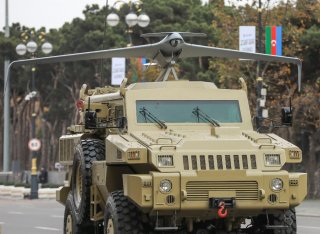Turkey’s Drones and Proxies are Turning the Tide of War
Turkey has shown that the combination of drones and proxy forces can radically alter how asymmetrical and regional conflicts are fought, just as the advent of close air support revolutionized fighting in the twentieth century.
With Armenia’s outdated military largely unable to counter drone attacks, Azerbaijan’s drones decimated Armenian air defenses and provided effective cover for Azerbaijani ground forces. Largely due to Turkey’s drones and guidance, Baku came out with a decisive victory, retaking 40 percent of the disputed Nagorno-Karabakh region and dramatically shifting the balance of power between Azerbaijan and Armenia.
Strategic objectives stemming from Erdogan’s foreign policy ambitions—most notably Turkey’s efforts to expand its influence in the Caucasus and decrease its reliance on Russian and Iranian energy imports—ultimately drove Turkey to move away from the non-interventionist approach it took to the conflict during the 1990s and throw its “unconditional” support behind Azerbaijan.
Recognizing the vulnerabilities posed by its dependence on energy imports from countries with which it has had increasingly strained relations in recent years, Turkey has dramatically increased natural gas imports from Azerbaijan in an attempt to diversify its energy supply. Due to Azerbaijan becoming Turkey’s primary natural gas supplier in early 2020 and the recent completion of a $6.5 billion pipeline that transports gas from Azerbaijan directly to Turkey, Ankara’s long-term energy security is largely dependent on Azerbaijan remaining secure and closely aligned with it.
Azerbaijan’s position as a wealthy state with one of the strongest militaries in the region makes it an increasingly valuable ally in Turkey’s efforts to increase its influence in the Caucasus. In addition to bolstering Azerbaijan’s strategic footing in the short term, Ankara’s support allowed Turkey to expand its military footprint in the Caucasus and provided Turkey with increased clout in Azerbaijan and the region as a whole. In early December, as Erdogan spoke at a victory parade in Baku that featured a procession of TB2 drones and Turkish commandos, it became clear that Ankara’s involvement in the war had solidified the Turkey-Azerbaijan strategic relationship.
Looking Forward
Turkey’s use of domestically produced drones in concert with Syrian proxies on the ground proved successful in achieving tactical victories on the battlefield and furthering broader Turkish interests in Syria, Libya, and the Caucasus. In addition to the strategic value of this approach, it has allowed Erdogan to reap the political benefits of appearing to assert Turkey’s power without the risks, costs, and international backlash that comes with large-scale military interventions. As Erdogan seeks to advance his expansionist foreign policy while battling for domestic support amid Turkey’s most serious economic crisis in decades, this model will be increasingly attractive as a low-cost way to project power abroad.
More broadly, Turkey has shown that the combination of drones and proxy forces can radically alter how asymmetrical and regional conflicts are fought, just as the advent of close air support revolutionized fighting in the twentieth century. Turkey’s neighbors must recognize the implications of Erdogan’s ambitions and work to prevent Ankara from spreading its influence inside their borders.
Will A. Smith is an editorial intern at The National Interest and a graduate student at American University's School of International Service.
Image: Reuters

